Marketing automation is no longer a “nice to have” but a line item your leadership expects results from. To make a strong case, you need data that justifies decisions, supports budget shifts, and highlights gaps in your current systems.
That’s why you’re here. In this article, we'll give you the latest numbers on adoption trends, marketing ROI, platform performance, and how other B2C or B2B companies are streamlining their marketing processes. Whether you're refining a deck, validating a proposal, or guiding a tech investment, this data will back you up.
Let’s start with the key numbers you should have at hand.
Key Marketing Automation Statistics in 2025
Marketing teams are under pressure to show clear results. Marketing automation tools promise efficiency, but real proof lies in the data.
Here are the most important marketing automation statistics you should know for 2025:
1. About 50% of companies currently make use of marketing automation.
2. According to Grand View Research, the global marketing automation market was valued at USD 6.65 billion in 2024 and is expected to grow to USD 15.58 billion by 2030, with a CAGR of 15.3% between 2025 and 2030.
3. 70% of marketing leaders plan to increase investment in automation in 2025.
4. Nucleus Research shows that businesses see an average $5.44 return for every $1 spent on marketing automation, translating to a 544% ROI over three years.
5. According to Comosoft, companies using marketing automation see a 10%+ boost in revenue within 6-9 months due to improved lead management.
6. HubSpot reports that 77% of marketers use AI-powered marketing automation to create personalized content in 2025.
7. A survey by Pedalix found that 34% of companies use marketing automation in a limited way, 25% have fully adopted it, 28% plan to start using it in the next two years, and 13% haven’t adopted it yet.
Marketing Automation Adoption and Usage Statistics
Marketing automation has now become the standard. As more companies shift resources into automation platforms, usage trends are revealing where adoption is strongest, which teams are leading the charge, and what tools are gaining traction.
These are the latest data-backed insights into how businesses are adopting and using marketing automation.
8. Approximately 75% of businesses are now using some form of automation in their marketing processes.
Widespread adoption shows that automation has become a baseline expectation in marketing tech stacks. Mid-sized businesses are especially accelerating usage to cut manual work and improve campaign timing. As your competitors automate at scale, your manual workflows will slow execution and increase overhead.

9. According to HubSpot, marketing teams are using automation 76% more than sales teams and 139% more than finance departments.
Marketing departments remain the core users of automation, outpacing both sales and finance by large margins. This reflects their need to coordinate multiple touchpoints, run cross-channel campaigns, and manage lead nurturing at scale. Yet, without stronger alignment, disconnected automation efforts can reduce shared visibility and impact results.
10. 91% of organizations report that internal demand for automation has increased across departments (marketing, R&D, ops, customer service, etc.).
Growth in automation happens in all departments and even between them. Teams in customer support, R&D, and operations are increasingly requesting automation tools to reduce delays and improve output. This internal pressure creates urgency for shared platforms and stronger campaign management governance.
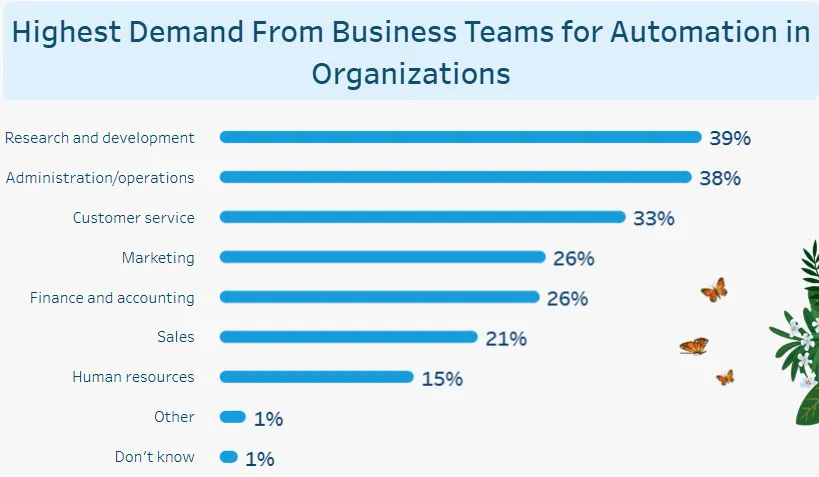
11. According to Mordor Intelligence, large enterprises held 62.5% of the marketing automation market in 2024, while SMEs are growing fastest with a 15.2% CAGR through 2030.
Enterprise teams continue to dominate spending, but small and mid-sized businesses are catching up quickly. With easier access to platforms like ActiveCampaign and Mailchimp than 5-10 years ago, SMEs are scaling automation without massive upfront costs. SaaS pricing models, freemium tiers, and plug‑and‑play UX have made automation accessible to small and mid‑sized businesses. This leveling field increases competition and compresses response time across markets.
12. For marketing automation, Mordor Intelligence reports that North America accounted for 37.5% of revenue in 2024, while Asia-Pacific is set to grow at a 15.8% CAGR through 2030.
While North American firms currently lead in spend, Asia-Pacific’s rapid growth signals a coming shift in platform innovation and pricing. Rising adoption across the region will also increase pressure on global vendors to localize features and expand regional support for customer interactions. Besides, marketers in this area will face increased competition.
13. According to a report from Adobe for Business, 69% plan to increase marketing program budgets, 90% of respondents say they are satisfied with their current marketing automation platform (MAP), and 29% are “somewhat likely” to switch platforms for better innovation, features, or integration.
Satisfaction with current tools remains high, but feature gaps and poor integration still drive churn. Marketers are open to switching if platforms can improve AI support, CRM systems compatibility, or user interface.

These statistics hide:
- An opportunity: If you master your current MAP and squeeze every feature out of it, you can compete with peers who are distracted by switching costs.
- A threat: If you ignore innovation, the 29% who move to newer platforms may leapfrog you with better automation, AI, or integration.
Basically, satisfaction doesn’t equal safety. Even if you’re happy with your MAP, your competitors are increasing spend and some are switching to gain an edge. The question is whether you’ll innovate in place or risk being outpaced.
14. The Adobe for Business report states that 98% of marketers consider integrating marketing automation with a CDP very important, and 94% say the same about CRM integration.
Tight integration with data platforms is becoming standard. Without real-time syncing between automation, CDPs, and CRMs, teams struggle with fragmented customer profiles and delayed insights. This means unified systems should become a key priority for you, for both strategy and execution.
15. According to Ascend2’s report, 59% of marketers say their customer journeys are partially automated, 32% are mostly automated, and only 9% are fully automated.
Most teams still rely on a mix of manual and automated steps, especially when handling complex B2B journeys. Limited data flow and platform silos are common blockers. For full automation, businesses must invest in system integration and map out the customer journey with more precision.
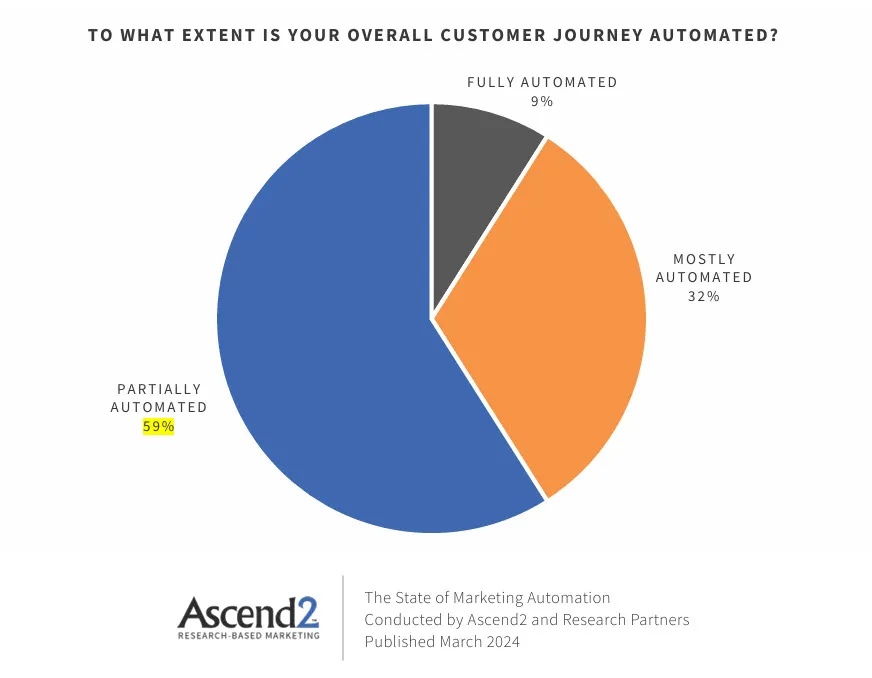
Pro tip: Your automation flows are only as good as your personas. That's why, you may need persona development services to help you get sharper segmentation, better triggers, and stronger performance.
16. Ascend2’s report notes that the most common uses of marketing automation heading into 2025 are email marketing (63%), social media management (50%), content management (33%), SMS marketing (30%), campaign tracking (28%), live chat (24%), and SEO efforts (22%).
Email dominates because it’s the easiest channel to automate at scale: most CRMs come with built‑in email workflows, it doesn’t require heavy integrations, and every business needs it to nurture leads. That’s why it’s often the very first automation step.
By contrast, SMS, live chat, and SEO sit much lower not because they’re useless, but because they’re harder to systematize. SMS and chat need stricter compliance, careful personalization, and can feel intrusive if over‑used. SEO “automation” often only means reporting or technical fixes, so adoption is naturally smaller.
For marketers, that means email and social are table stakes, while channels like chat or SMS remain underused opportunities for differentiation if applied carefully.

17. According to Mordor Intelligence, cloud-based marketing automation made up 66.3% of spending in 2024 and is set to grow at a 13.9% CAGR.
Cloud-hosted systems are growing fast due to easier deployment, AI-readiness, and remote access. Teams also value faster product updates and lower infrastructure overhead. This shift supports Agile marketing automation strategy development and quick adaptation to new campaign needs.
ROI and Efficiency Gains from Marketing Automation
Marketing automation is a measurable revenue lever. For marketing leaders under pressure to prove value, the right strategy shows up clearly in pipeline growth, budget efficiency, and faster lead qualification.
Here are the key data points that demonstrate how automation impacts ROI and overall efficiency in 2025.
18. According to Ascend2’s State of Marketing Automation report, 28% of marketers rate their strategy as best-in-class, 69% say it's somewhat successful, and only 3% consider it unsuccessful.
These numbers show that while most teams are gaining traction, the gap between “somewhat successful” and “best-in-class” lies in strategic depth. High-performing teams usually have better platform integration, clearer KPIs, and stronger collaboration across departments. Without these, automation efforts can stall after initial setup.
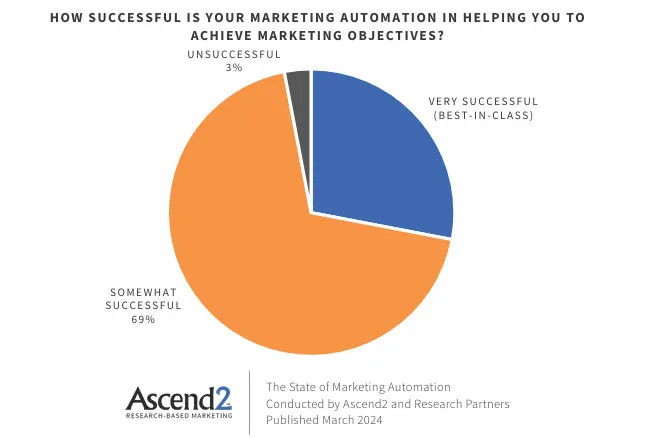
19. According to Ascend2’s report, the top automation goals for 2025 include identifying ideal customers (47%), improving data quality (40%), reducing costs (39%), increasing personalization (37%), and integrating technologies or data (27%).
The priority list reflects a shift from basic execution to smarter, data-informed decisions. Teams want clearer customer insights, seamless systems, and more targeted messaging. Achieving these goals usually requires updated workflows, cleaner data pipelines, and platform consolidation.
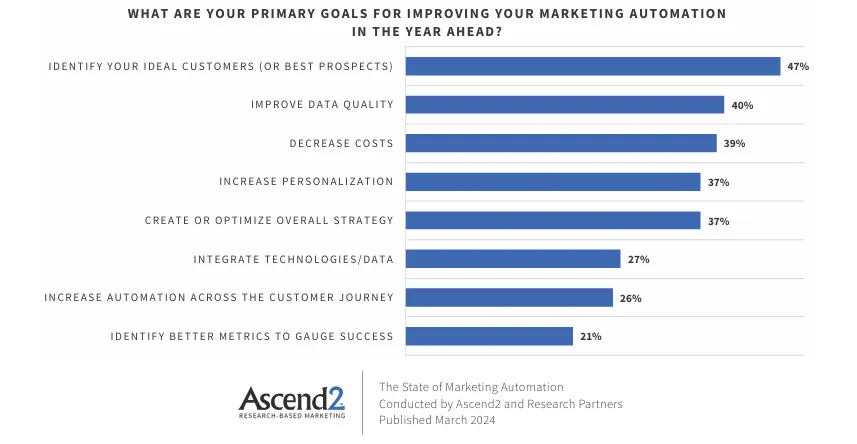
20. Another report from Adobe for Business states that 76% of companies see positive ROI from automation within one year, and 12% start seeing results in under a month.
Quick returns are possible when teams enter with clear objectives, reliable data, and a mapped-out process. Tools like HubSpot or ActiveCampaign speed up execution, but real gains depend on strategic implementation. Without upfront planning, even the best platform can miss early targets.
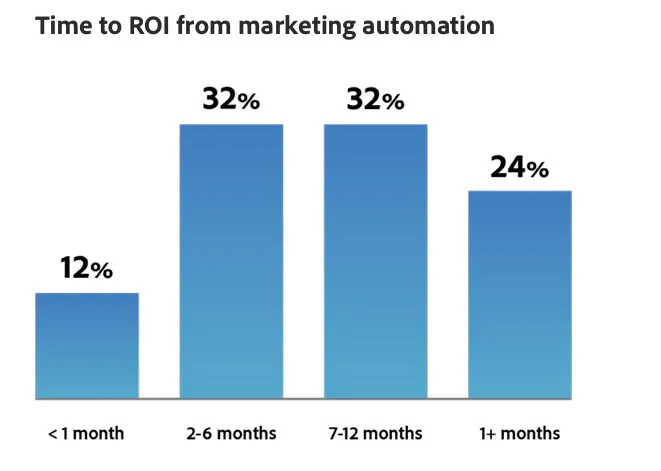
Pro tip: Marketing attribution doesn't just cover automation workflows. For a clear picture of impact, media mix modeling helps you tie spend to results across all channels, including automated touchpoints.
21. According to Salesforce, businesses using marketing automation achieve a 25% increase in marketing ROI on average.
Efficiency gains usually come from automating repetitive tasks, accelerating lead qualification, and optimizing content delivery. This frees teams to focus on high-impact work like refining email campaigns or testing new formats. As a result, your campaigns run faster and convert more predictably.
22. Adobe’s research similarly found companies leveraging automation drive 25% higher revenue than those that do not.
Teams using automation at scale benefit from faster cycle times and improved message consistency. Revenue lift is most evident in mid-funnel tactics like personalized marketing campaigns, where timing and relevance play a critical role. Manual approaches can’t match this precision or speed.
23. Software Path notes that businesses have an 80% increase in the number of leads when using automation, and a stunning 451% increase in qualified leads when automation is used for lead nurturing and prospect engagement.
This performance jump is linked to automation’s ability to segment, time, and respond to behavior across channels. When paired with advanced behavioral and life cycle segments, teams deliver the right message at the right moment. This tight alignment drives quality, not just volume.
Pro tip: Curious how automation stacks up against other lead gen channels in 2025? Check out our 60+ lead generation statistics that will help you compare your own efforts and spot weak links.
24. 80% of marketing automation users say these tools help generate more leads for their sales funnel.
Automation removes manual bottlenecks, increases frequency, and improves lead flow consistency. By feeding the sales funnel more efficiently, marketers support stronger handoffs and faster decision-making. The result is a smoother transition from interest to conversion.
25. According to the Adobe for Business report, top-performing marketers are 27 times more likely to exceed ROI targets and 10 times more likely to excel in customer experience and pipeline growth compared to lower performers.
The difference comes down to strategic use of automation for full-funnel execution. Leading teams connect tools, track outcomes, and refine quickly. Their edge lies in using automation to sharpen execution across the entire campaign lifecycle management process instead of simply aiming for faster speed.
Email Marketing Automation Stats: Does It Work?
Marketing automation plays an important role in email performance and revenue growth. For data-driven marketers, email automation helps prove ROI, drive conversions, and streamline follow‑up across drip flows and welcome sequences.
Here are the key metrics showing whether email marketing automation really delivers in 2025.
26. Mordor Intelligence reports that email marketing made up 27.9% of 2024 revenue. Analytics and reporting tools are projected to grow at an 18.0% CAGR due to rising interest in attribution and ROI tracking.
This level shows automation’s strong impact on overall marketing strategies, especially when using integrated analytics tools. But scale brings scrutiny: leaders want proof that this spend actually drives returns. That’s why analytics and attribution platforms are growing at an 18% CAGR: they give marketers the ability to connect email and other automated flows directly to revenue. For marketers, the message is clear: running campaigns isn’t enough; you need the reporting infrastructure to defend and optimize the budget behind them.
27. Forbes reports that email marketing yields an average return of $36 for every $1 spent, resulting in a 3600% ROI.
The extraordinary ROI makes email marketing a top-performing channel compared to paid ads or social. It’s ideal for showcasing ROI in executive presentations or justifying budgets. Implementing consistent A/B testing and dynamic content further multiplies these returns over time.
Additionally, email’s 3600% ROI explains why it remains the anchor of most automation strategies. Automating campaigns in a channel that already delivers outsized returns compounds efficiency.
That means you reach more people with less manual work, while keeping margins high. For marketers, the implication is twofold: email is the clearest proof point to defend automation budgets, and it sets the ROI bar that other automated channels will be compared against.
28. Forbes also notes that 58% of businesses incorporated automation into their email marketing strategies in 2024.
What this shows is a growing trust in automation as part of everyday email outreach. However, you have to get this step right. Teams that adopt automated flows early lead in conversion and retention. In contrast, lagging companies fall behind in responsiveness and scalable follow‑up.
29. According to Klaviyo, automated email flows have an average open rate of 48.57% across industries, with top performers reaching 65.74%.
These flows outperform manual sends by a wide margin. Top performers hit 65.74%, usually due to list segmentation and well-timed triggers. Better engagement like this drives higher workflow email open rate and stronger deliverability benchmarks.
30. On average, automated emails generate 320% more revenue than non-automated emails.
That gap shows automation’s power when paired with behavioral triggers and timely outputs. Whether it’s welcome series, reengagement, or drip sequences, automation increases conversion rate significantly. Teams can reinvest that revenue back into growth tools or additional testing.
31. According to Omnisend, brands sent 250 million more automated emails year-over-year, with the biggest jumps in back-in-stock (4x), welcome (2.5x), and browse abandonment (2x) messages.
You’ll see volume growth in welcome, browse abandonment, and back‑in‑stock messages. These targeted sends show that brands are leaning into event-driven automation. Smart scheduling ensures messages feel relevant without overwhelming subscribers.
32. The same report noted automated emails outperformed campaign emails with open rates rising from 25.2% to 42.1%, click rates increasing from 1.5% to 5.4%, and conversion rates nearly four times higher.
These improvements reflect better customer segmentation and triggered timing. When campaigns align with user actions, response rates and revenue increase. This reinforces why automated flows should be a priority over batch sends.
33. Omnisend reports that automated emails made up just 2% of all sends but drove 41% of total email orders.
This stark imbalance highlights the efficiency of automation. A small send volume can deliver major results if targeted and correctly timed. It shows why investing in automated workflows is a high-impact move.
34. Omnisend reports that 1 in 3 people who click on an automated email ends up buying, compared to just 1 in 20 for campaign emails. Welcome and cart abandonment emails perform even better, converting nearly 1 in 2 clickers.
That conversion gulf shows how timing and context matter in automation. When clickers receive relevant offers via welcome or cart recovery, purchase rates skyrocket. Structured sequences like these usually outperform generic newsletters hands down.
35. Omnisend states that 88% of all automated email purchases came from welcome, browse abandonment, and cart abandonment emails.
These specific flows carry the highest purchase power and reflect best-practice design. Marketers should prioritize those flows if their tool supports email marketing automation. They deliver both quick wins and long-term ROI from automation infrastructure.
Social Media and Content Automation Stats That Matter in 2025
Automation is reshaping how teams manage social media workflows and content operations. When platforms automate posting, moderating, and ad placement, marketers can shift focus from manual tasks to strategy and analytics.
Here are the key statistics that highlight the impact of social media automation in 2025.
36. DemandSage found that 47% of small businesses use automation tools to handle their social media accounts.
That adoption level shows automation has become a core tool for lean teams. Small businesses using platforms like Buffer or Hootsuite can post consistently across channels. For mid-sized teams, that frees up hours for social media posts and strategic content planning.
37. According to a report by DemandSage, 47% of marketers automate social media, making it the second most commonly automated marketing channel.
This places social media just behind email in automation priority. It reflects marketers’ need to streamline content marketing workflows and maintain consistent brand presence. Without automation, teams risk falling behind in engagement and response time.
38. Data from DemandSage shows that automating social media content and ads can save businesses around six hours of work per week.
That time gain adds up (over 300 hours annually per marketer). Teams can redirect this capacity toward analytics, creative planning, or improving customer loyalty initiatives. The extra bandwidth usually improves both productivity and strategic output.
Pro tip: Stale creative can sink your automation ROI. So, you might need to work with performance creative agencies because they know how to keep content fresh, testable, and performance-ready at scale.
39. By automating half of their social media comment moderation, DemandSage estimates that social media teams can save up to 175 hours every month.
Handling comments manually eats up valuable hours daily. Automation via tools like Sprout Social or Zendesk can flag and respond to common queries instantly. The result is faster customer support, reduced response delays, and more consistent brand voice.
If you’re seeking alternatives to Zendesk, check out this insightful guide on other customer-service platforms that may better align with your team’s workflows and budget.
40. As per DemandSage’s research, 64% of marketers juggle social media alongside other duties and automation offers major relief.
When teams balance multiple responsibilities, manual posting and community moderation become a bottleneck. Automation helps maintain consistency without overloading staff. That supports smoother marketing efforts and prevents burnout at scale.
B2B Marketing Automation Statistics
B2B companies are scaling their efforts to drive pipeline growth, and automation now plays a central role in that push. As teams handle longer sales cycles, deeper data integration, and more complex buyer journeys, they’re leaning heavily on automation to close gaps and improve throughput.
These are the most important B2B marketing automation statistics shaping strategy in 2025.
41. An overwhelming 98% of B2B marketers say that marketing automation is critical to their organization’s success.
This shows that automation is foundational to how B2B teams operate. From lead scoring to pipeline forecasting, marketers rely on platforms to handle scale and speed. It also indicates executive alignment around its strategic value.
42. 46% of B2B organizations report using marketing automation extensively in their marketing operations.
Nearly half of B2B firms have already moved beyond experimentation. They’ve embedded automation into workflows, campaign management, and customer lifecycle programs. This adoption pace pushes the benchmark higher for those still working through implementation.
43. According to a report from Adobe for Business, most B2B marketing leaders plan to increase their investments with 75% boosting spend on marketing technology, 69% on marketing programs, 58% on agencies or consultants, and 55% on marketing staff.
This breakdown shows that leaders aren’t just investing in tools. They’re also building the talent and external support to execute. It reflects a full-funnel shift toward automation-backed operations. For mid-sized teams, these trends set expectations for competitive growth.
44. The same report also shows that 75% of B2B marketing leaders plan to increase investment in marketing technology, including automation platforms.
B2B marketers are prioritizing automation to shorten sales cycles and deliver measurable outcomes. As budgets grow, investments will likely focus on integrations, personalization, and lead generation efficiency. Delaying upgrades may widen the performance gap across teams competing in crowded segments.
45. 67% of B2B marketers say marketing automation has led to at least a 10% growth in their sales pipeline.
Pipeline impact is one of the clearest indicators of automation’s success. This growth usually results from improvements in campaign targeting, CRM synchronization, and timely follow-ups. It also highlights the compounding value of refined workflows over time.
Platform Benchmarks: Marketing Automation Tools by the Numbers
Marketing automation tools vary widely in scale and specialty. Understanding market share, revenue impact, and customer growth for major platforms can help you compare options more accurately.
These are the key benchmarks you should review for leading marketing automation tools in 2025.
46. Datanyze shows that HubSpot holds 29.36% of the marketing automation market share, followed by Oracle Marketing Cloud at 5.91%, Adobe Experience Cloud at 5.46%, and ActiveCampaign at 4.92%.
HubSpot’s dominant share signals its widespread enterprise and mid-market adoption. Oracle, Adobe, and ActiveCampaign trail but retain niche strengths in B2B or SMB segments. Selecting a platform with visible market traction usually ensures better community support and feature validation.
47. According to HubSpot’s 2025 report, their AI tools boosted inbound leads by 99% in six months and increased web traffic by 143% over a year.
Doubling leads and accelerating traffic in under six months highlights the impact of AI-driven workflows. These gains typically come via automated lead nurturing, optimized forms, and SEO-boosted landing pages. For SaaS teams, such metrics justify investment in advanced content creation and AI-powered targeting.
48. HubSpot’s 2025 report states that 87% of marketers using CRMs like HubSpot felt confident in their strategy, compared to just 52% without a CRM.
Confidence in strategy rises sharply with CRM-led automation. That reflects tighter alignment between sales funnel processes and campaign operations. Teams gain better visibility into performance and smoother handoffs when the CRM is central to automation strategy.
49. There are 388 providers offering marketing automation solutions.
With hundreds of vendors vying for attention, choosing the right tool depends on prioritizing features, support, and integrations. Niche tools might excel at one channel but lack cross-channel capability. You’ll need to weigh flexibility against specialization to avoid vendor lock-in and mismatched functionality.
50. As of March 31, 2025, HubSpot counts 258,258 customers, marking a 19% year-over-year increase.
Strong customer growth indicates platform stability and ongoing innovation. Companies that grow 19% annually tend to invest heavily in product updates and ecosystem partnerships. This momentum raises confidence that if you’re using Hubspot, your tool won’t stagnate as your needs evolve.
51. In Q1 2025, average subscription revenue per customer for HubSpot was approximately $11,038, a slight decline (~4%) from the previous year.
This metric suggests pricing has plateaued or shifted amid competitive pressures. Slight revenue per customer drop implies either discounting or plan rebalancing. It may signal more flexible entry points for SMBs or greater value bundling in enterprise packages.
52. In Q1 2025, international revenue accounted for 47% of total revenue for HubSpot, growing 15% year-over-year (as-reported) and 19% in constant currency.
Nearly half of HubSpot’s revenue now comes from outside North America. This reflects growing global penetration and support ecosystems in Europe and APAC. Companies based on other continents gain assurance on regional compliance, local integrations, and support availability.
53. Companies using Salesforce’s marketing automation platform have seen up to a 34% increase in customer lifetime value.
Improved lifetime value comes through better segmentation, upsell automation, and consistent nurturing. With the right setup, automation can deepen account relationships over time. Teams should consider Salesforce when tight CRM alignment and automation matter.
54. Mordor Intelligence reports that Oracle’s cloud services revenue of USD 5.9 billion in Q2 FY2025 illustrates the scale of post-sale value creation that accompanies platform uptake.
Oracle’s revenue figures reflect strong enterprise demand and customer retention. Continuous investment ensures the tool stays competitive and expands integration capabilities, just like in Hubspot’s case. That makes Oracle a contender for teams with complex enterprise workflows and service demands.
55. Oracle, backed by Eloqua, has been recognized as a Gartner Magic Quadrant Leader in B2B marketing automation for 12 consecutive years.
Consistent recognition highlights both product maturity and long-term stability. Leaders in the Magic Quadrant typically support deep workflows, enterprise compliance, and complex buyer journeys. Teams in highly regulated industries may benefit from Oracle’s enterprise-grade infrastructure and support.
56. A recent Forrester Consulting study found a composite ROI of over 330% for organizations using Adobe Experience Cloud.
That level of return shows high value when Adobe tools are implemented holistically. ROI stems from advanced personalization, multi-channel analytics, and automation across content, email, and web experiences. For teams with mid-to-large budgets, Adobe usually delivers in-depth reporting and flexible architecture.
57. According to enricher, ActiveCampaign reported significant gains such as 15-22% improvement in customer retention rates and up to 17% higher engagement using features like predictive send times.
These uplifts reflect effective use of timed sends, segmented workflows, and engagement optimization. Improvements in retention and engagement suggest strong platform usability for lean teams. It makes ActiveCampaign a reliable option for SMBs focused on high ROI with minimal overhead.
58. enricher also shows that automation efficiency is another highlight where a client cut manual marketing tasks by 50% through ActiveCampaign’s workflows.
Halving manual effort usually relates to seamless triggers, well-defined templates, and conditional rules. Reduced task load lets teams refocus on strategic planning or creative testing. That efficiency gain is a key reason ActiveCampaign remains popular with mid-sized B2B marketing teams.
Challenges and Barriers of Marketing Automation That You Need to Know of
Marketing automation offers efficiency, but it also comes with operational hurdles that delay returns or limit success. Many B2B teams struggle with technical upkeep, poor data input, or unclear strategies, which hurt performance and ROI.
These are the most important challenges you need to watch out for in 2025.
59. Ascend2’s report lists the top challenges in marketing automation as collecting quality data (52%), developing a clear strategy (47%), securing budget and resources (41%), and creating effective customer journeys (40%).
These issues usually stem from poor CRM hygiene, fragmented tools, and unclear ownership across departments. If data quality drops or workflows break, it limits personalization and slows pipeline velocity. Marketers must improve data capture at source, standardize fields, and coordinate with sales on journey mapping.
Pro tip: Automating campaigns is one thing. Feeding them with high-quality targeting data is another. Programmatic agencies can help bridge that gap for better outcomes.
60. About 73% of marketers say they find marketing automation challenging to implement and manage.
The difficulty usually lies in configuring logic, syncing tools, and building workflows without developer support. Many marketers are also undertrained on advanced functions or forced to use legacy systems. Simplifying onboarding, automating documentation, and assigning platform owners can ease the lift.
61. 96% of organizations report that modifying or rebuilding automated workflows is tough because business needs and systems keep changing over time.
Constant changes in offers, customer behavior, or internal tools make workflows outdated fast. Without modular structures and version tracking, even small edits can break sequences. Teams need automation tools that support dynamic rule updates and offer built-in testing environments.
62. According to Content Science Review, 70% of marketers are dissatisfied with their current marketing automation tools, and 85% of B2B marketers believe they aren’t making full use of their software’s capabilities.
This signals a steep learning curve, poor onboarding, or misalignment with team structure. Features like A/B testing, segmentation, or predictive scoring can easily go underused. Improving usage means you may need vendor-led audits, team-level enablement, and realistic configuration roadmaps.
63. Ascend2’s report also notes that 11% of marketers expected their marketing automation budget to decrease.
Budget cuts can freeze optimization projects, delay integrations, or prevent switching to more scalable platforms. For many teams, that means running complex campaigns on outdated tech. Leaders should justify spend by tying automation metrics to revenue influence and sales productivity gains.
64. 49% of B2B marketers identify collecting quality data as a challenge when using marketing automation to boost performance.
Missing or inaccurate data weakens scoring, targeting, and analytics. Without structured inputs, personalization breaks down and teams default to batch campaigns. You need clean forms, updated CRM fields, and validation rules to improve output from automated campaigns.
Future Trends and AI in Marketing Automation
Marketing teams are moving fast to integrate AI into everyday campaigns. The goal isn’t just efficiency but about smarter workflows, better personalization, and more consistent output across formats and channels.
These are the top AI and future trends you need to keep on your radar.
65. According to Adobe for Business, 72% of marketing leaders are confident in using AI to improve their marketing efforts, as long as there’s some human involvement.
Trust in AI rises when marketers retain control over final decisions and strategy. Leaders want tools that support their teams’ judgment, and not replacements. The biggest gains come when AI handles repetitive tasks while marketers guide outcomes with context and experience.
66. The Adobe for Business report shows how high-performing marketing teams are actively using generative AI: 67% use it to create content, 66% to summarize content or conversations, 62% for visual content, 58% to build digital chat experiences, and 56% to assist with sales conversations led by humans.
These applications show how AI is shifting from experimentation to core workflows. The overlap with customer service and sales suggests cross-functional value. Strong alignment across these touchpoints is now critical because it can boost consistency and speed across the entire multichannel customer journey. Conversely, automation silos risk breaking customer experience.
Pro tip: AI-powered UGC is streamlining how brands produce content for automated flows. If you're scaling touchpoints, this is where the creative edge starts.
67. According to HubSpot’s 2025 State of Marketing report, 92% of marketers say AI has already influenced the way they work.
This signals that adoption is moving past early pilots. AI tools are being used for campaign sequencing, real-time performance feedback, and audience matching. Teams that leverage this shift early can reallocate hours to strategy, testing, and message refinement.
68. HubSpot’s 2025 report shows that 1 in 4 marketers plan to use AI to turn text into multi-modal campaigns, while 1 in 5 aim to adopt AI agents for full campaign automation.
Marketers are testing new ground by combining generative AI with automation to create text, visuals, and voice in one workflow. Early adopters expect major gains in productivity and message consistency. As AI becomes native to platforms, creative teams may shift from builders to orchestrators.
69. According to the 2024 State of Marketing AI Report, only 20% of marketers currently automate over 25% of tasks using AI, but 78% expect to surpass that threshold by 2027, and 45% anticipate automating more than half of their marketing tasks with AI in the same timeframe.
That expected jump means internal processes, roles, and success metrics will all shift. For example, teams may spend less time building and more time evaluating model performance. Marketers need to develop skills in prompt design, tool assessment, and workflow scoring.
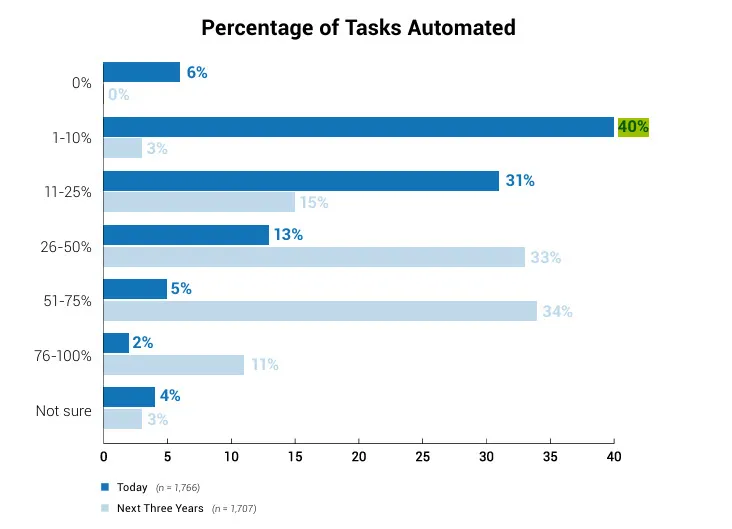
70. By 2028, the value of the AI market in marketing is expected to climb to $107.54 billion worldwide.
This growth suggests deeper investment across adtech, martech, and CRM ecosystems. As vendors push AI deeper into core features, teams will have to vet tools on more than just cost. They’ll need to assess privacy safeguards, bias risk, and transparency controls.
Final Thoughts: Why Marketing Automation Should Be On Your Radar
The data shows a clear path forward. Marketing automation helps you scale faster, personalize better, and connect systems across your funnel. When used right, it saves time, sharpens how you capture demand, qualify leads, and improve retention.
The challenge is keeping workflows efficient while feeding them with the right content. That’s where performance media, UGC, and clean campaign inputs matter. If your team spends too much time on manual asset creation or influencer outreach, automation won’t work at full capacity.
Need help producing scalable content that fits into automated campaigns? inBeat Agency can support your next phase of growth. Book a strategy call to map out your next steps with clarity and impact.
FAQs
What is meant by marketing automation?
Marketing automation refers to software systems that manage repetitive workflows (e.g., email campaigns, lead scoring, segmentation) in a scalable way. Instead of doing everything manually, you set up workflows that run based on triggers like user behavior or time delays. It helps you scale your marketing without hiring more people.
Which marketing automation tool is best?
There isn’t a general answer for this question. HubSpot works well for growing SaaS companies that need a CRM integration. Marketo is better for enterprise-level needs. If you’re focused on eCommerce, Klaviyo or ActiveCampaign may suit you more. Pick based on your use cases, budget, and tech stack.
Pro tip: Picking the right tool starts with understanding your analytics needs. If you’re unsure what data capabilities matter most, check out our guide on picking a good marketing analytics agency that helps you solve this with ease.
How to start with marketing automation?
Start by documenting your lead flow. Map your buyer journeys, define your campaign goals, and then match those to a platform. Begin with small, high-impact workflows (like welcome emails or cart reminders) and track results before expanding across your funnel.
Does marketing automation really work?
Yes, when used strategically. Companies using automation for lead nurturing and segmentation usually see higher conversion rates and shorter sales cycles. The key is aligning it with your sales team and using real-time customer data to drive actions.
What is the future of marketing automation?
AI is reshaping automation. You're going to see more tools that use AI to personalize campaigns, write content, and predict behavior. That means less manual setup and more real-time optimization driven by customer insights.
Does automation save money?
Automation does save money if you set it up well. That means aligning workflows with measurable KPIs like CAC or pipeline influence, integrating automation tightly with your CRM and sales process, and running regular audits. You’ll reduce manual labor, shorten campaign cycles, and speed up lead follow-up. That said, poor implementation or unused features can waste time and budget.
What are the disadvantages of marketing automation?
Without clean data, automation won’t work well. Many teams also struggle to maintain workflows as the business changes. Some tools can become overly complex or lead to generic messaging if not carefully managed.
How much does marketing automation cost?
It depends on your scale and tool. Basic email platforms like Mailchimp offer free plans, while full-suite solutions like HubSpot or Marketo can cost $1,000-$10,000+ monthly. Factors include contacts, automation depth, integrations, and support. Always match features to your exact workflow needs.

